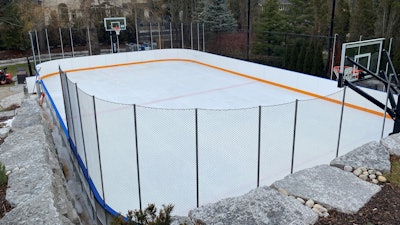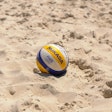
During his busiest time of year, Nick Garofalo is at Danbury Ice Arena in Connecticut six days a week. As arena operations manager, he makes sure the speedskaters who use the facility on weekends have time to warm-up at 6:30 a.m. for their 7 a.m. timeslot — or even an hour earlier, if one of the monthly youth hockey tournaments Garofalo stages needs the ice time. The last adult hockey game on any given day may end around midnight, so Garofalo finally gets to lock up the building shortly thereafter — or not.
“We know how the adult league guys are, and we love them. They’re usually trying to stay a little bit later, so we’ll push sometimes till like 1:30 a.m.,” Garofalo says. “So, it’s a long day, right? The building is certainly used a lot — September to March. I don’t see much sun, especially with the winter hours being so short. But I love it, and that’s why I do it. I do it for the community. And I have the summer to defrost on a beach somewhere.”
But even this summer proved busier than most, and in unanticipated ways. Ice sensor replacement and waterproofing, as well as additional arena upkeep, opened an atypically large window for the annual ice melt, leaving five weeks of bare concrete on the facility floor and Garofalo just enough time to get creative.
“My father worked at Danbury Hospital, so I remember growing up, and there used to be a roller-skating rink in Danbury,” he says. “I remember going there. I remember the wooden floors, the four wheels, the disco music and disco lights. Nostalgic, I wanted to take an idea and turn it into life. So, we started spit-balling the idea. ‘Well, how long is the concrete slab going to be exposed? Is this something we can market and potentially turn our ice-skating crew into a roller-skating following? A lot of the comments from the public were reminiscing on the old days of roller skating, and there was a lot of excitement for it. There was a lot of interest in it. It was an idea and people took to it, and it was pretty cool to see.”
The arena, which is bankrolled by a parent company, ordered roughly 150 pairs of four-wheeled skates, featuring wheels specified to stand up to concrete and sizes ranging from 5 to 12, at a cost of around $2,500. It charged $17 to skate and $5 for rentals (skaters were welcome to bring their own skates, including inline models), figures that mirrored the arena’s fees for its popular in-season DJ Skate (“Think pizza karaoke on ice,” Garofalo says), which can pack the rink with 300 skaters. “We kind of had a similar thought, ‘Okay, it’s Friday night. I don’t have ice skating to do, so I’m going to try roller skating.’ The numbers weren’t 300 by any means. Our biggest night was 50, but that’s better than having no one skate on an empty surface, right? We were still utilizing the slab.”
And much more. “Now, here’s the thing,” Garofalo adds. “We made a large time period for the roller skating — Fridays was 3:30 to 9 p.m. — so if you were a skating junkie, and you wanted to skate from 3:30 to 9, you could do that. We did have a few individuals who would skate, get food and beverage from our concessions stand, play in our state-of-the-art arcade, and then they went back out there and skated, which is what we were hoping for. We just want to capture someone for the longest period of time and enjoy different things in the building.”
 The Oakville installation in summer.Photo courtesy of Custom Ice
The Oakville installation in summer.Photo courtesy of Custom Ice
Maximizing usage
So much of ice facility management is about time, “shoehorning people into the time that they can get,” as Garofalo puts it. But what about rinks with even shorter seasons and greater downtime? How are they programmed for maximum usage?
One Canadian company specializes in building rinks that serve off-season purposes — from splashpads to pickleball courts.
“In the old days, lots of operators only ran ice rinks seasonally, and often the rinks would sit idle during the summertime,” says Glenn Winder, project manager for Burlington, Ont.-based Custom Ice, which has built outdoor rinks as far south as Tennessee. “And then they start saying, ‘Hey, that’s great public space. Maybe we should use it for trade shows. Maybe we should use it for community events.’ And that’s what’s happened. As people got more free time and recreational time, they started to develop the seasonal indoor rinks into ball hockey, ball box lacrosse and stuff like that.”
Custom Ice’s design-build approach takes many forms — from outdoor skating paths to full-size professional arenas. Potential programming variety is best exemplified in outdoor settings, where refrigeration infrastructure can host ice sports for five months of the year, then convert to other purposes during the summer, and back again.
For example, a slab of concrete hosting outdoor basketball, tennis, pickleball or badminton — and often all of the above — can be mechanically chilled in winter to host ice skating, too. The process may involve building ice right through a court’s perforated plastic tile surface (game lines painted directly on concrete are discouraged as they tend to inhibit the bond between concrete and ice). Once the ice profile reaches the top of the tile, a white sheet of perforated, pliable plastic is spread over the rink and more water is added. “We just freeze that right into the ice to give you the white color, and then build it up,” Winder says. “If you want hockey lines in it, then you build it up a little bit, put your hockey lines on and put your ice on top of that. It might be two inches, two and a half inches of ice.”
That’s a large profile, perhaps a full inch thicker than the typical indoor rink. “These rinks are designed for outdoor use in the wintertime,” Winder says. “Nature’s helping you for a bit. When it’s not helping you, that perforated white sheet that you put down is helping you, because that’s reflecting the sun away from the rink instead of absorbing it into the dark colors.”
 Photo courtesy of Custom Ice
Photo courtesy of Custom Ice
Water and ice
Another type of conversion brings different considerations. “Where we do some more unique work with municipalities is in outdoor splashpads,” Winder says. “A community might say, ‘Well, we can’t do an outdoor rink and a splashpad,’ so we came up with the idea to integrate the ice rink into a splashpad. All your mechanical for the splashpad we can do, and then all the mechanical for the ice rink we can do. We put it all together in one system.”
Because splashpads need to drain substantial amounts of water, their surface is sloped. It also is dotted with fountain nozzles and possibly play equipment. Neither prohibits a pad supported by a refrigeration plant from hosting seasonal ice skating. Spray jets are winterized and capped, and any above-surface play structures are removed and stored. Custom Ice favors the former conversion over the latter. “We go light on the above-ground features, because they just mean more stuff to take down and set up again in the spring,” Winder says. “We’re not worried about that; it’s just that we find lot of communities love the spray option. Kids really just want to run around and get wet and cool. It’s all computer controlled, so different ones are shooting up, and kids chase them around. If you want climbing apparatuses and guns and a heavy-duty, real sophisticated splashpad, that’s not us. We’re more into giving you seasonal options.”
Whereas most rink slabs are designed to be perfectly flat in the interest of ice-making and refrigeration efficiency, a sloped splashpad represents a deviation. Says Winder, “You’re going to have a little bit thicker ice as it goes toward the drain, so the whole system, including the mechanicals, is all designed to accommodate for that.”
Custom Ice can’t provide the type of resilient surface found on some splashpads and still accommodate ice. The compromise is a concrete finish brushed just enough to bond with ice while being easy on little feet.
The bigger challenge proved to be a splashpad’s drains, which can be large and numerous. “That was actually our Achilles heel when we were designing this whole concept,” Winder says. “Let’s say the drain is 12 by 12 inches. That was too wide to refrigerate because our pipes are an inch and a half on center, and that would leave a spot that couldn’t be frozen. We actually patented a drain that has predesigned pipes through it, and that solved the problem. It’s a drain in the summertime, and in the winter you just cap off the drain and then these predesigned metal ice rink pipes bring the refrigeration that gives you the ice you need to cover that area over.”
The end result is enhanced ROI for municipalities. “Now you can have two to three months of your splashpad, and then when it’s cold enough to turn the ice rink on, you can have an ice rink for four to five months, when it would otherwise just sit there idle in the shoulder seasons and winter,” Winder says. “You’ve effectively used that investment three times more than you would have.”
 Roller skating on an ice rink’s concrete slab.Photo courtesy of Danbury Ice Arena
Roller skating on an ice rink’s concrete slab.Photo courtesy of Danbury Ice Arena
Garofalo has worked at Danbury Ice Arena for 16 years, starting as a hockey coach, then hockey director, then program director, now arena operations manager. He’s no stranger to reinvention. But this summer was something special.
“Quite honestly, the marketing of the roller skating opened up different ideas and different avenues for our slab,” he says. “I had a couple individuals contact me about floor hockey, so we did a couple floor hockey events. We even did learn-to-play ball hockey to try to teach a sport to someone who may have not been introduced to hockey. And then we also had another individual reach out to schedule a couple of nights for roller hockey. We were utilizing the slab for different functions other than our normal ice hockey, which is pretty neat.”
It didn’t end there. Garofalo’s summer also included the booking of youth boxing, a high school graduation and a Brazilian music concert. “When anyone gives me a phone call and asks, ‘What do we do at the rink?’ I say we do more than ice. We’re not just an ice rink. We’re an arena. We’ve done a variety of different events, whether it be on ice or concrete subfloor,” Garofalo says. “To have a concert, a boxing event, a graduation, roller skating, roller hockey, floor hockey — all in one summer — you kind of shake your head, and you’re like, ‘How do we have this much time?’ ”
And now his busy season begins.






































